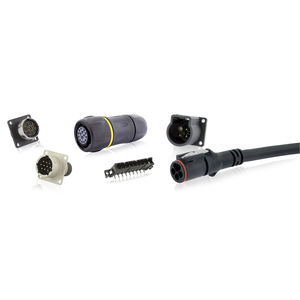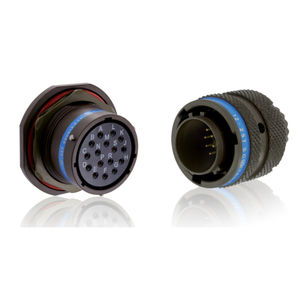
- Products
- Catalogs
- News & Trends
- Exhibitions
Data connector VGE1 - FER1 Seriesquadraxfiber opticcircular


Add to favorites
Compare this product
Characteristics
- Type
- data
- Format
- quadrax, fiber optic
- Shape
- circular
- Connection type
- bayonet
- Product applications
- for railway vehicles
- Domain
- outdoor, for railway applications
- Protection class
- IP67
- Other characteristics
- ultra-rugged
- Operating temperature
Max.: 125 °C
(257 °F)Min.: -40 °C
(-40 °F)
Description
•Salt spray : 500h
•IP67 in mated condition (static and dynamic)
•Compliant to International Fire Smoke standard :
•EN 45545 : HL3/R22
•NFPA 130
•Durability : 500 mating/unmating cycles
•Shock and vibration resistance acccording to EN 61 373 - Cat.2
•Resistance to fluids: Gas oil, mineral oil, acid bath, basic bath, following NF F 61-030, oxalic acid
•RoHS and REACH compliant
The VGE1 1/3 bayonet coupling series was designed for railway equipment manufacturers, subcontractors, signaling and infrastructure companies. Robust and ruggedized, VGE1 connectors are suited for 500 mating and unmating cycles and are derived from MIL-DTL-5015 and VG95234 standards.
With only a 1/3 twist of the bayonet, connectors are mated with an audible click and tactile feel to confirm proper mating. This mating system eliminates uncertain connection and reduces time and labor during installation.
The VGE1 connectors are resistant to salt spray as well as high vibrations and adapted for outdoor applications such as rolling stock or infrastructure equipment.
Available with electrical contacts, quadrax and fiber optic technologies in the same shell design; you can customize VGE1 connectors to your application needs.
These solutions are qualified according international railway standards: EN50467, EN45545, NFPA 130, RoHS and REACH.
VIDEO
Catalogs
No catalogs are available for this product.
See all of EATON‘s catalogsRelated Searches
- Souriau-Sunbank connector
- Souriau-Sunbank data connector
- Souriau-Sunbank electrical power supply connector
- Souriau-Sunbank metal connector
- Junction block
- Terminal box
- Souriau-Sunbank round connector
- Cable conduit
- Souriau-Sunbank plastic connector
- Souriau-Sunbank screw-in connector
- Souriau-Sunbank rectangular connector
- Socket electrical connector
- Protection conduit
- Souriau-Sunbank circular connector
- Wall-mounted terminal box
- IP67 electrical connector
- Male connector
- Souriau-Sunbank cable connector
- Plastic conduit
- Cable assembly
*Prices are pre-tax. They exclude delivery charges and customs duties and do not include additional charges for installation or activation options. Prices are indicative only and may vary by country, with changes to the cost of raw materials and exchange rates.



















